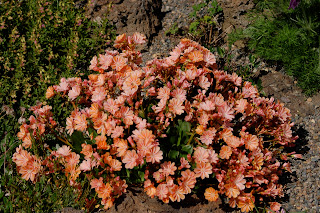Lewisia cotyledon is a spring flowering, evergreen succulent found in the Siskiyou Mountains of Southern Oregon and Northern California. Vigorous hybrid varieties have been developed with colorful spring flowering displays and an extended flowering period.
 |
| Lewisia mound in rock garden |
Lewisias are found in rocky crevices in nature and work well in alpine gardens, scree beds, tucked into rock walls and in raised beds. They also make attractive, long-lived container plants.
 |
| Lewisia cotyledon in scree |
Lewisia cotyledon should be grown in very well-drained, low fertility soil and do best in Western climates where humidity is low during the summer months. Although they can grow happily in full sun, the blooming period is prolonged if given some afternoon shade. Their fleshy, succulent leaves make them drought tolerant but they benefit from some rainfall or irrigation during the flowering period.
 |
| Lewisia cotyledon 'Sunset Strain' |
Customers occasionally report that the foliage at the base of their plants has turned yellow. This situation can be caused by a variety of factors:
1. It can be a natural process as new leaves are formed toward the center of the rosette and the older, outer foliage turns yellow, leathery and eventually dries up. In assessing how a plant is doing, we look at the health of the central leaves. If they are plump, green and healthy, the plant is usually OK.
2. Any soft, mushy leaves and especially mushiness at the base of the Lewisia is a sign of moisture related problems. If plants end up dying with the plants "popping off" at soil level, they have probably been over watered and/or the soil is too heavy. Excessive moisture can cause crown rot. Under watered plants just become more leathery, lose turgor and don't flower as well. It is better to underwater than overwater.
3. Another possibility is that the soil is too rich. If Lewisias are grown in too fertile soil they may be more likely to have what we call a "long neck" from overgrowth. The foliage at the base of the plant dies off, leaving the central caudex exposed. It can be unsightly and these plants are probably not as long lived as those grown in poor soils.
 |
| Lewisia cotyledon var purdyi |
Add inorganic soil amendments such as crushed rock and sand to heavy soils. This has the dual benefit of improving drainage and decreasing soil fertility.
 |
| Lewisia cotyledon 'Rainbow Strain' |




After seeing your Lewisia mound I made one and it is full of blooms in all different colors right now.
ReplyDeleteGreat! Thanks for sharing your success.
ReplyDeleteMost of our Lewisia at Pittock Mansion are making a beautiful show, as well - certainly causing people to stop along their stroll. As you know, we started to reclaim our Rock Garden in the Fall of '09, removing the smothering hypericum and heather and discovering existing plants and a host of opportunities for new. We added four varieties of L.cotyledon, plus pygmaea and columbiana. Although we should have known better, I confess we got impatient and planted before we prepared our clay well to provide better drainage. If we have lost any plants, I'm pretty sure that's a contributing factor - at least a controllable one, the weather is not. One of these days I'll take some pictures to share.... Skip
ReplyDeleteThanks for the update on the Pittock Mansion Rock Garden. I still hope to visit some day very soon so I can enjoy the results of all the hard work. I've heard glowing reports from people who have visited in recent months.
ReplyDeleteostin kukan kesäkuun alussa, nyt on 17 kukkavarsi kukassa ei oluslautasta suihkutusta lehdille on tosi kaunis olut koko kesän
ReplyDeletetosi ahkera kukkija,kesäkuusta lokakuun loppuun kukkinut koko ajan 17 kukanvarsi nyt miten lie elää talvenyli
ReplyDeleteMy lewisia has a long neck, but the plant on top looks healthy. Is that normal? Should I cut it down to ground level? Thanks.
ReplyDelete